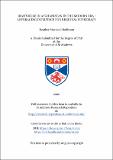Iran's role in Afghanistan in the modern era : leveraging influence for regional supremacy
Abstract
This dissertation provides an in-depth historical analysis of the motivations and actions
surrounding Iran’s foreign policy toward Afghanistan in the modern era. The need for
this research stems from a significant gap in Western scholarship on the Iranian-Afghan
relationship that accounts for any period of the countries’ interactions in detail. It is
argued here that despite rhetoric to the contrary, successive Iranian governments
consistently pursued policies of political, military, and economic interference in
Afghanistan as an integral part of Iran’s desire to achieve a dominant position of
leadership in its region. This persistent approach has been grounded in both the historical
experience and the mythology surrounding Iran’s once-great status as an empire, which
was destroyed by the Afghans and the great powers during the colonial period, and the
resultant Iranian irredentism toward Afghanistan that followed. In analysing the course of
Iran’s policy toward Afghanistan, a defining feature is that it has never been divorced
from Iran’s competition against the great powers that have continuously been involved in
Afghanistan and the region. This work first provides a long-view historical context of the
Iranian-Afghan relationship, which demonstrates that since Afghanistan separated from
the Persian Empire in 1747, Afghanistan held an important place of relevance in the
perpetuation of myths that underpin the persistent ideology of Iranian nationalism, which
manifest in an Iranian foreign policy of interventionism toward Afghanistan. This,
combined with the continued strategic importance of Afghanistan to the great powers and
their encroachment on Iran and Afghanistan, heavily influenced Iran’s foreign policy
toward Afghanistan. During the Cold War, Iran used the power gained from aligning
with the United States to develop political, economic, and military dominance over
Afghanistan and leveraged that to successfully attain regional leadership separate from
the United States and in competition with the Soviet Union. When the Islamic Republic
was created in 1979, despite its ideological and structural differences from previous
Iranian regimes, the policy toward Afghanistan and its importance to Iran’s wider foreign
policy aims, were consistent with previous regimes’ motivations. This regime’s ‘export’
of Iran’s Islamic revolutionary influence to different Afghan polities during the Soviet
occupation was a religious manifestation of the same Iranian nationalist ideology that
was primarily concerned with advancing Iran’s regional position in competition with the
Soviet Union and the United States.
Type
Thesis, PhD Doctor of Philosophy
Collections
Items in the St Andrews Research Repository are protected by copyright, with all rights reserved, unless otherwise indicated.

